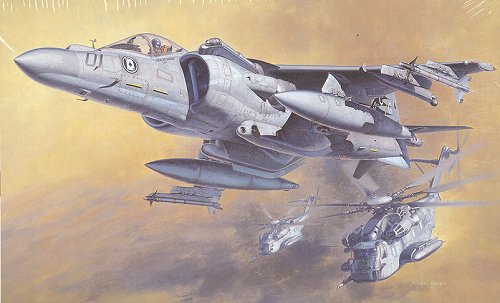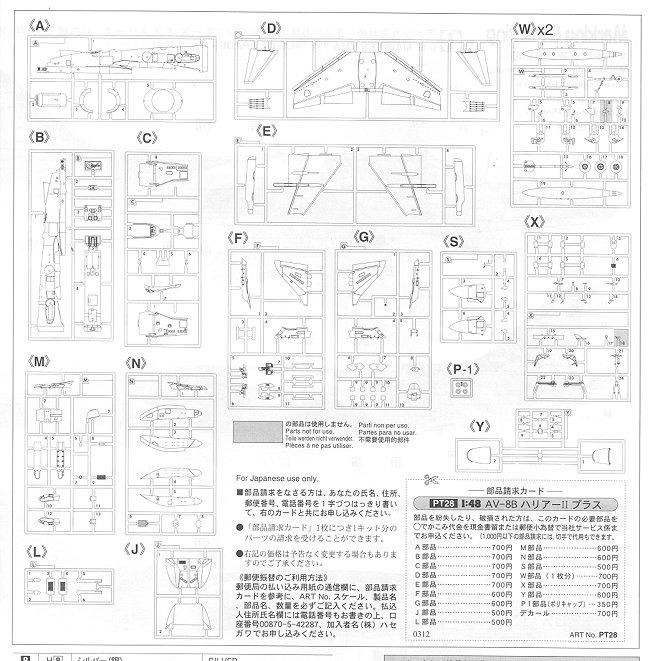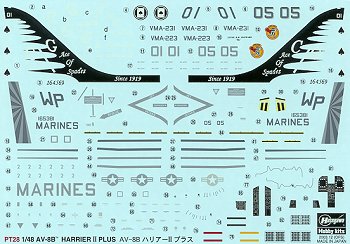
|
KIT: |
Hasegawa 1/48 AV-8B Harrier II Plus |
|
KIT # |
7228 (Pt 28) |
|
PRICE: |
$29.98 MSRP |
|
DECALS: |
Two options |
|
REVIEWER: |
Scott Van Aken |
|
NOTES: |
All new tool kit |

|
HISTORY |
The original AV-8A/C aircraft entered service with the Marines some time in the late 1970s and were put through their paces. While they were not that difficult to operate and showed a lot of promise, they were constricted by a rather limited payload. Not wanting to let this hamper things, McDonnell/Douglas went a step farther and developed the AV-8B which, along with a more powerful engine, had a larger airframe and the ability to carry a greater payload than the earlier Harrier. The British saw the wisdom in this and opted into the program for the very similar Harrier GR.5 and later aircraft.
AV-8Bs started entering Marine service in 1985 and have been continually upgraded and improved with each subsequent batch. One of the latest is the Harrier II plus which adds a radar system to it for the first time in US Harrier operations. This allows the Harrier to actually perform as a viable air to air aircraft as well as improving ground attack capabilities. It doesn't hurt that it is basically the same radar as carried in the Hornet so there is some system savings in that regard. The most important addition other than the new radar is that the Harrier II plus is now AMRAAM capable and that gives it BVR capabilities only dreamt of a decade earlier. This variant of the Harrier II has been in service nearly a decade as of this writing (Feb 2004).
|
THE KIT |
Fresh on the heels of Revell's latest reboxing of the old Monogram Harrier II kit, this one is a brand new tooling, something that modelers delight in. Cheap it isn't though it could be a lot more expensive. If I thought I'd be paying $30 for a 1/48 Harrier ten years ago, I'd have thought myself insane. Yet I also thought that $18 was an outrageous price for the first Hasegawa 1/48 F-4s back many decades ago. Things change and one of them is the price of new kits.
Starting with the packaging, it will be of no surprise to anyone that the clear bits are in one bag and the rest of the parts in another. The clear pieces have large blocks on the end of the sprue to help keep the parts from being damaged in the crush. Thanks to the way the canopy and windscreen are shaped, you'll have to sand down the seam that runs down the middle of them both. There is no MDC etched in the canopy, that is provided on the decal sheet.

There are 16 different sprues jammed into the bag so you definitely get a LOT of plastic (one of the reasons I've wimped out and put up a scan of the sprues from the instructions). All but one three small parts are used in the making of the kit so according to the side of the box, that is 166 bits of plastic, both big and small. A weekender this won't be. As with their 1/72 kits, there are plastic inserts to hold the vectored exhaust in place. This makes it very nice for when it is time to build the kit and allows you to pose them at various angles. All of the intake blow-by doors on the top are separate so that you can pose them in the down position when the aircraft is at rest.
As with the 1/72 kits, you have few options when it comes to the underside of the plane. You can install or leave off the lower gun pods. You have fuel tanks, FLIR pod (with a moveable seeker head) and a pair of Sidewinders for the outer missile rails. The diagram shows that if you install the FLIR, you leave off the fuel tanks. No other ordnance is provided so you'll have at least three empty pylons. Typical of a kit that will have a zillion variants, there are a lot of plug-in sections. These will test your construction skills to ensure that things are properly lined up and filled. I should also mention that the canopy is a separate frame and glass piece. Many of us do not like this arrangement as it makes it quite difficult to get a good seam between the clear bit and the framework. This was, of course, done to allow for the different canopy frames, but I'd have liked to have seen it done as a single piece.
Hasegawa seems to have done their homework in regards to making ejector pin marks invisible. While there were a few (missiles and gear legs for example) they were not there in a lot of places that one normally finds them. Kudos to Hasegawa for decent engineering.
 Instructions
are what we have come to expect from Hasegawa with a lot of information
packed onto a long sheet. One side has all the various construction steps
and includes interior colors and any holes to be drilled/filled. Color
references are Gunze as always. Markings are included for two planes. One
is the box art aircraft from VMA-231 in a somewhat colorful (for a
Harrier) scheme. The other is a VMA-223 aircraft. Colors given for
painting are (from the top) FS 35237, 36320 and 36375. These seem to be
the colors I used on the 1/72 AV-8B I did a while
back, and I got e-mails telling me they were not correct. One thing for
sure, the lower two colors were so close to each other that you really
had to strain to see the differences in shading. These decals are very
comprehensive and include the IR slime lights as are on the real planes
at this time. My last experience with Hasegawa decals was quite positive
and I do believe these will be the same. The white areas appear a bit
translucent even on the sheet so you do need to be aware of that. I
should also point out that the chaff/flare dispensers and instrument
panel/consoles are provided as decals and only reinforce the detailing
that is already on these parts so it isn't like you can't detail those
areas yourself if you choose.
Instructions
are what we have come to expect from Hasegawa with a lot of information
packed onto a long sheet. One side has all the various construction steps
and includes interior colors and any holes to be drilled/filled. Color
references are Gunze as always. Markings are included for two planes. One
is the box art aircraft from VMA-231 in a somewhat colorful (for a
Harrier) scheme. The other is a VMA-223 aircraft. Colors given for
painting are (from the top) FS 35237, 36320 and 36375. These seem to be
the colors I used on the 1/72 AV-8B I did a while
back, and I got e-mails telling me they were not correct. One thing for
sure, the lower two colors were so close to each other that you really
had to strain to see the differences in shading. These decals are very
comprehensive and include the IR slime lights as are on the real planes
at this time. My last experience with Hasegawa decals was quite positive
and I do believe these will be the same. The white areas appear a bit
translucent even on the sheet so you do need to be aware of that. I
should also point out that the chaff/flare dispensers and instrument
panel/consoles are provided as decals and only reinforce the detailing
that is already on these parts so it isn't like you can't detail those
areas yourself if you choose.
|
CONCLUSIONS |
I'm sure there is much cheering out there over this particular kit and I know it will do well. There was an 'early 2004' release sheet in with the kit and two other kits are planned for release later this year: a regular AV-8B 'Desert Harrier' (from Desert Storm) and AV-8B 'Night Attack' version. These kits have been selling very well as the place I bought mine can't keep them in stock more than a day before they are gone.
If you would like your product reviewed fairly and fairly quickly by a site that has nearly 250,000 visitors a month, please contact me or see other details in the Note to Contributors.